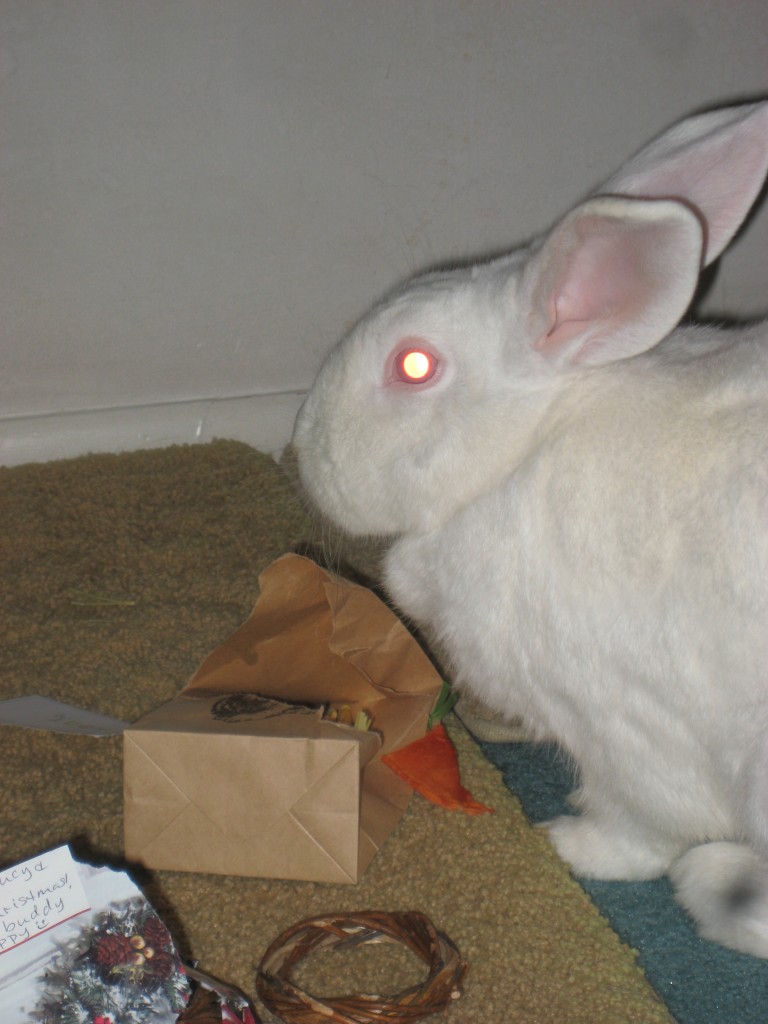Many aspects of how rabbits are put together are a mystery to the people who have them. This article is to help unravel one of those mysteries for you, a rabbit’s vision.
We see a broad color spectrum with lots of depth perception to help us navigate the world around us. Rabbits being prey animals, have evolved with eyes on both sides of their head in order to see 360 degrees. This is so they can always be on the lookout for approaching predators. Ironically, a rabbit has a blind spot directly in front of their nose. Their whiskers and smell are normally used to detect things in that area (and sometimes their teeth).
Bunnies are far sighted and do not see very well up close. They also tend to see in greens and blues because most of their food is green stuff.
Rabbits see things in two dimensions. They do not easily tell distance and have virtually no depth perception. They can see a cat, but cannot visually tell if it is ten feet or fifty feet away. Their vision can identify a cat, but they tend to use their other senses such as smell and hearing to determine how far away it is.
When a rabbit sees things with both eyes, he sees a flat picture that is similar to page in a coloring book. Imagine taking one of those extra wide panoramic pictures and wrapping it completely around your head and then being able to see the whole picture at once. This is hard for most people to imagine and conceptualize. This is why we don’t easily understand a rabbit’s vision. It is absolutely nothing like our own.
Then add to that the lack of a full color spectrum and the inability to see things up close and now you are beginning to understand a rabbit’s vision. This is why they tend to rely more on their hearing and sense of smell to alert them to danger around them. Their vision is important, but for up close work (like eating) they use their nose more than their eyes.
I often have people ask me about a common rabbit phenomenon called, eye scanning. It is a bit disturbing the first time you see it and it consists of a rabbit kind of weaving and bobbing like a drunk person in order to look at something. The first time I saw it, I thought the bunny was developing some kind of neurological problem or MS.
It turns out that it is more common in red eye bunnies, but I have seen a couple of non-red eye bunnies do it, as well. Usually the bunny will be sitting upright and his head will kind of weave from side to side. If you look closely, you will see that he is eying or looking closely as something, switching from one eye to the other in his gazing at it.
What he is actually doing is trying to get a better look at something, by using both eyes to view it. I think that for some rabbits, it helps them better gauge their surroundings. I think that they do it more when they are unsure of a location or curious about what is happening nearby.
My big New Zealand bunny does not care for cats and will thump whenever she sees or hears them. Often, she will start thumping and I cannot figure out what she is alerted to. Then I will see a cat way way off in the distance that she is seeing. To her she just sees a cat. She does not know if it is ten feet away or over one hundred feet away, like it really is.
Another common mystery is, why rabbits have red or pink eyes. This is actually the result of albinism. It was intentionally bred into bunnies in order to have a blood line that would produce all white bunnies all the time. Albinos of all species have pink or red eyes because it is due to the complete lack of pigmentation within their bodies. Normally it is a mutation, but this mutation has been bred to exclude all other varieties, in rabbits.
This is usually a recessive trait in most species and so when any genes are present to give color, the color is dominant and will be present. However, it is possible for a non-albino to give birth to an albino (all white with pink eye) offspring due to both parents have the recessive gene hidden in their DNA.
Albinos are sensitive to sunlight, due to their lack of pigmentation and red eye white rabbits are no exception. They can find glaring bright sunlight a bit annoying and will often seek shade to comfort their sensitive eyes. Keep this in mind when taking your red eye bunny out and about. Their sensitive eyes and skin do not like hot direct sunlight.

